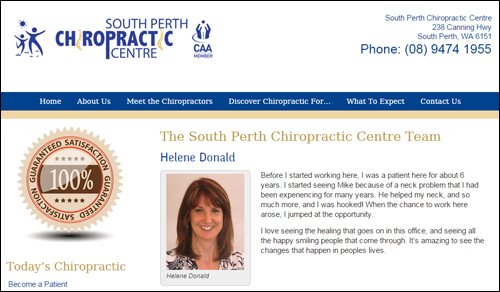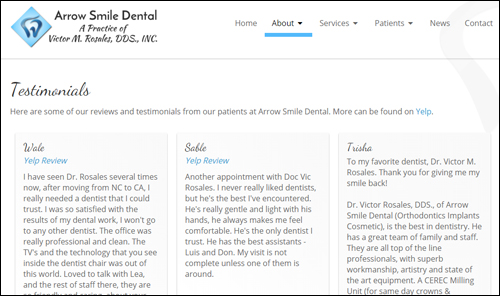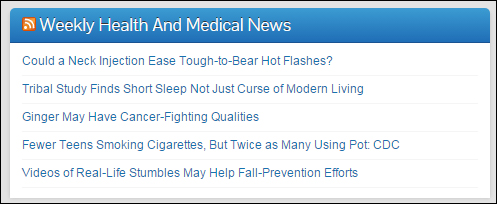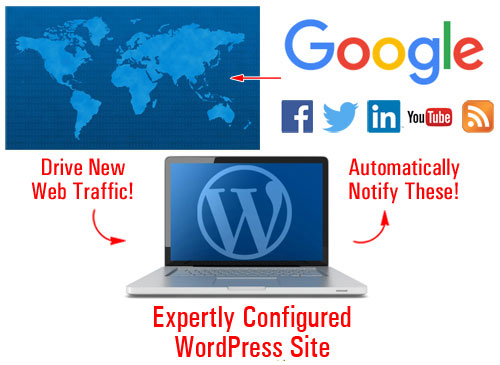Grow Your Medical Or Healthcare Business Online With WordPress
 Health services professionals face many new challenges in the digital economy, especially in terms of growing a business presence online.
Health services professionals face many new challenges in the digital economy, especially in terms of growing a business presence online.
Challenges Health And Medical Services Professionals Face Online
Now, more than ever, businesses in the medical and health sector must work harder than ever to remain competitive. Not only do you have to be fully involved in the community you serve, you must also develop an active digital presence. This includes having an effective website and figuring out better ways to market your health or medical services services online.
In addition to investing money advertising offline on newspapers, ads in industry publications and magazines, radio and television spots, etc., you will probably find that in order to remain competitive, you will need to designate a larger portion of your budget towards the development and maintenance of a website that brings in clients, engages users, outperforms the competition in search engines and social media, and helps to give you a wider amount of exposure online.
This means that your website not only has to look professional, load fast, and be easy to navigate, but it’s also important to keep in mind that the needs of your website will change in time and sections will need to be updated frequently. This requires implementing sound web and content management strategy.
Another challenge that medical or health-related businesses face with their websites (as do most professions for that matter), is that they have only around thirty seconds or less to provide visitors what they are searching for or they will leave your site and go elsewhere.
“Websites have evolved into central information hubs where service information is still present but enhanced with web portals, hyperlinks to state and federal sites, and a variety of free tools.”
Michael Alter, http://www.accountingweb.com/technology/accounting-software/tips-for-improving-your-website
Opportunities For Medical And Health Services
As well as facing many business and technology changes, there are also loads of online opportunities available for medical or health-related practices that can evolve to meet online challenges and think outside the box when it comes to improving their online business marketing skills.
The guide below will help you uncover new opportunities to generate more client accounts and see noticeable improvements in your online results.
![]()
As well as providing useful website improvement tips, we also recommend that you consider using the WordPress Content Management System to power your medical-related website or blog.
To learn more about the benefits and advantages of using the WordPress Content Management System, see the articles below:
- Why A Poorly Constructed Web Site Can Lose You Business And What To Do About It
- The Small Business Owner’s Guide To WordPress
Practical Tips To Improve Your Website
In this section we will show you how to improve your website and get better results. We show you what pages you need, what type of content works best, navigation structure, etc.
If you need website planning assistance, check out the detailed step-by-step guide we have written here: A Cost-Saving Guide To Web Site Planning For Business Owners
Your Website Pages
Professional business websites need some essential web pages. Let’s take a look at the pages your need to have and how to set up your medical-related website for best results.
Services
It’s essential to include a page that explains your services or products. Depending on which area of health or medical services you specialize in, your page could list services such as:
- Medical And Surgical – e.g. ear, nose and throat, nephrology haematology, cancer, stroke, renal, infection control, eye diseases operating theaters, etc.
- Dental Services – e.g. cosmetic dentistry, holistic dentistry, cleaning services, teeth whitening, implants, emergency dental, etc.
- Cardiology – e.g. cardiac surgery, coronary care
- Prenatal and Postnatal – e.g. obstetrics, midwifery, etc.
- Child Health services – paediatrics, child development, children services, etc.
- Diagnostic services – mammography, skin cancer, radiology, women’s health, MRI scanning, allergy testing, etc.
- Pathology services – laboratory testing and analysis, routine pathology testing, insurance and corporate testing, speech pathology, etc
- Counselling services – mental health, alcohol, tobacco & other drug counselling, marriage counselling, wellness, social development services
- Alternative therapies – Chinese medicine, aromatherapy, functional medicine, yoga, chiropractic, hypnosis, etc.
- Other medical services – weight management, podiatry, fertility services, stomal therapy, inherited diseases, artificial limbs, hearing aids, home and community care, community health, medical equipment, etc.
List all of the services you provide. Provide your visitors with information that will educate them about what these services do and why they should choose you.
About Us Page
The ‘About Us’ page should give a description of your business and explain to visitors what it stands for, its unique approach, philanthropic donations, etc.
It should also include any awards, recognitions, accreditations, certifications, associations, publications, etc., that could be used to promote your medical services and position yourself above the competition.

(List all of your business awards accreditations, recognitions, certifications, associations, publications, etc. in the About Us page. Image source: squaremedical.com.au)
Staff
If you are searching for quicker and simpler ideas to grow your business online or get people to stay longer on your site, then something you can do, is make it easier for your visitors to get to know, like and trust you, your team and your business better.
Your business needs to be relatable. One great way to do that is to have a page that introduces your staff members. This page should include a photo and a brief bio. Since most visitors will not tend to be well-versed in medical or health-related terms it should tell who they are and what they specialize in. You may also want to explain what those specialties mean. This page can also include social buttons so your site visitors can follow your staff members on their social pages.
On this page, don’t be afraid to humanize your people with personal stories, hobbies, etc., but make sure to highlight each team member’s expertise, how their skills and knowledge add value to your team, and more importantly, how they can help add value to your clients’ business.

(Add a page that introduces your employees or team members to prospective new clients. Screenshot image sourced from: southperthchiro.com.au)
If you need help how to add a simple and easy-to-manage list of staff members to WordPress using free plugins, go here: Plugin Tutorial: How To Easily Add A Staff Directory To Your WordPress Site
Work For Us
List any career opportunities within your business. This page should include training offered, benefits, opportunities for advancement, social aspects of working with your organization, etc. You should also include information about upcoming career opportunities in the health-related industry.
Maintain a positions available section in your page. If there are no positions currently available, consider inviting people to return periodically to this page, subscribe to your announcements list, follow your social pages, etc.
Case Studies And Testimonials
Case studies and testimonials are a great way to attract potential clients and showcase what kind of services you offer. Adding a page with reviews from clients and case studies also provides social proof.

(Add a page with testimonials from past clients and case studies. Screenshot source: arrowsmiledental.com)
If you want to learn more about using case studies, testimonials and reviews, see this article: Turn More Visitors Into Qualified Leads With Awesome Testimonials
Contact Us Page
A clean contact page is vitally important.
It should include some or all of the following information:
- Company Name
- Your physical location
- Phone
- Facsimile number
- Google Map
- Website address
- Contact form
- Contact name
- Social media URLs
- Chat/Skype (optional)
If your business operates out of multiple areas you want to make this clear when showing the address and contact info.
Consider also including a few links point to commonly-asked questions page, frequently-visited pages, online booking request, helpdesk, newsletter, blog, etc.
Add A Health Blog
A blog is a powerful marketing tool for your business. Most blogging platforms typically include a content management system that allows you to easily promote your business using content such as events, updates, useful articles, informative posts, promotional videos, webinars, etc.
If you already have an established health website, then consider adding a WordPress-powered blog to promote your medical services.
If you don’t have a website yet, or if your existing site is hard to keep updated or not giving you the results you want, then WordPress can act both as your website and business blog.
![]()
Something few people know about, is that WordPress can turn your web presence into an automated traffic-generation system that can help attract a stream of web traffic to your website, simply by adding new content to your website on a consistent basis.
(An expertly configured WordPress site can automate your traffic generation)
For more info, see this article:
Legal Information Pages
As a professional medical services practitioner, ensuring that you have a website that complies will all legal requirements online is important. This is not only important for building trust with prospective clients, but also to ensure that no laws or regulations are being broken wherever you do business.
Depending on what products and services you provide, adding the legal pages below to your medical website will help keep you out of legal hot water with most regulatory authorities, third-party service providers (e.g. Facebook), and other potential sources of threats and legal inconveniences:
- Contact Us
- Privacy Policy
- Terms And Conditions Of Use
- Website Disclaimer
- Affiliate Agreement
- Anti-Spam Policy
- Compensation Disclosure
- DMCA Notice
- Earnings Disclaimer
- External Links Policy
- Health and Financial Disclaimers
- Refund Policy
- Video/Audio Terms
- etc.
Go here if you would like to learn more about adding legal pages to your website: What You Need To Know About Adding Legal Pages To Your Site
Ways To Improve The Content On Your Website
In today’s highly competitive online economy, having a sound content marketing strategy has become one of the key differentiators for businesses.
By committing to providing great content with useful advice, information and tips, you will get your readers sharing it with others and coming back for more content. Content marketing is a great way to inform and educate your visitors and prospective clients about using your services and products.
For example, if your business provides weight management services, then some of the areas you can cover in your content include:
- Emotional causes for weight issues (possible causes, identifying yours)
- How to identify the bad habits you need to correct to ensure permanent weight loss
- Recovering after weight loss surgery – useful tips and recommendations
- A guide to making the right choices when eating at restaurants
- And endless other content topics
You can also create a series of informative articles that will help your prospective clients gain a better understanding of your services, by explaining benefits, procedures, terminology, etc.
![]()
Use keywords and terms in your content that your readers would search to find you online.
We recommend subscribing to our Content Marketing Email Training Series. You will receive regular training emails with easy-to-digest information that will teach you how to drive more traffic to your website or blog, save money creating high-quality content that will add value to your visitors and grow your presence online using content marketing strategies. It’s not only a great course with loads of useful information, it’s also 100% FREE!
Tips For Improving User Experience
Improving user experience (generally referred to as UX) helps keep visitors coming back and using your site. This section will show you ways you can improve visitor engagement and UX.
Adding RSS Feeds
RSS feeds can help to improve visitor engagement and UX in many ways.
If you provide valuable information, other sites will want to syndicate your content to their visitors.
Some of the benefits of having other businesses syndicate your content, include:
- All of your updates are in one place
- Doesn’t rely on email
- Your feeds can be shared
- Users can subscribe to your RSS feed
- An RSS feed provides links back to your site
- Feeds can be submitted to RSS directories and aggregators
- There are multiple ways your readers can receive your content (e.g. users can view the content on their mobile device using a feed reader)
- RSS is built into WordPress
There are also benefits to providing content on your site from other websites, such as the fact that you don’t have to write, manage or update the content.
You can find many useful RSS feeds for your website by visiting sites of medical and health-related government departments and industry bodies.
Here are a few RSS feeds you could add to your website:
- US Department Of Health And Human Services – e.g. Latest news feed: http://www.hhs.gov/rss/news/hhsnews.xml, etc. You can also select specific feeds, like feeds on women’s health issues (e.g. Breast cancer, Fitness and nutrition, Illnesses and disabilities, Minority women’s health, Screening tests and vaccines, etc.) here: http://womenshealth.gov/news/rss/rss-feeds.html
- US National Libraries Of Medicine – For a list of RSS feeds from various medical journals, publications and websites (e.g. BMJ Quality and Safety in Health Care, BMJ Heart, The Journal of Immunology, Current Psychiatry, BMJ Journal of Epidemiology & Community Health, etc.) go here: http://www.healthplusplus.com/wiki/List_of_RSS_feeds_on_health
- National Institutes Of Health - Find various feeds on health-related topics here: http://www.nih.gov/Subscriptions.htm
- US Food And Drug Administration (FDA) – Get FDA-related feeds (e.g. FDA drug safety, FDA drug shortages, tainted products marked as dietary supplements, animal and veterinary news, etc.) and podcasts here: http://www.fda.gov/AboutFDA/ContactFDA/StayInformed/RSSFeeds
- Department of Health UK (https://www.gov.uk/government/organisations/department-of-health) – Latest news: https://www.gov.uk/government/organisations/department-of-health.atom
- The Department Of Health (Australian Government): http://www.health.gov.au/internet/main/publishing.nsf/xml/rssLatestNews.xml
- Department Of Public Health (Australia – State Level): e.g. Victoria – http://www.health.vic.gov.au/rss/newsfeed.xml
- Centers For Disease Control And Prevention (www.cdc.gov) - Find various RSS feeds on health-related news and podcasts here: http://www2c.cdc.gov/podcasts/rss.asp
- Medical News: You can search medical news feeds in major news publications like the NYTimes feeds section (e.g. Health news: http://www.nytimes.com/services/xml/rss/nyt/Health.xml)
- MedicineNet – MedTerms Medical Word of the Day: http://www.medicinenet.com/rss/dailyword.xml. You can also choose specific RSS feeds here (http://www.medicinenet.com/rss/article.htm) (e.g. Medications, Men’s health, Migraine Headaches, Depression, Prevention & Wellness, Heart, etc.)
- Medical News Today – Featured Headlines: http://rss.medicalnewstoday.com/featurednews.xml
- MedicalNewsToday.com – You can also select individual feeds here: http://www.medicalnewstoday.com/newsfeeds-rss (e.g. Stem Cell Research, Immune System/Vaccines, Cervical Cancer/HPV Vaccine, Dermatology, Food Intolerance, Respiratory/Asthma, Personal Monitoring/Wearable Technology, etc.)
You can also search online for general feeds, e.g. “medical rss feeds” or search for feeds on specific areas, e.g. “fibromyalgia rss feeds”, “nutrition rss feeds”, “MRI rss feeds”, etc.

(Add RSS (Really Simple Syndication) feeds to provide your visitors with a better user experience.)
Checklists And Forms
Adding checklists and educational charts to your site is a great way to increase visitor engagement and add value to your visitors. They can provide visitors with useful step-by-step instructions and resources to perform necessary tasks. Checklists and charts are great educational tools.
You can provide online or downloadable forms and checklists covering a range of subjects such as:
- Checklists/forms for booking appointments
- Checklists for pre or post surgery
- Health checklists for specific conditions
- Dental checklists – e.g. first visit, oral hygiene program, cosmetic dentistry, etc.
- Weight loss and exercise program checklists and charts
- General charts & infographics (e.g. sugar content in different foods, the importance of sleep at different ages, etc.)
Add Unique Tools
Providing unique tools and applications on your site can help increase visitor engagement and add value to users. Health-related calculators, for example, are useful tools for your website. Other applications can include things like nutritional tools, or even recipes.
In part two of this guide, we will be discussing a several online tools you can use in your site using WordPress plugins that improve seo, improve user engagement and drive more traffic to your business.

***
This is the end of section 1 of this step-by-step guide on ways to build your medical business web presence.
To view the rest of this guide, click here:
***
***
"These tutorials have so much information and are easy to understand. If you use WordPress or plan to in the future these will help you with everything you need to know." - Valisa (Mesa, Arizona)


